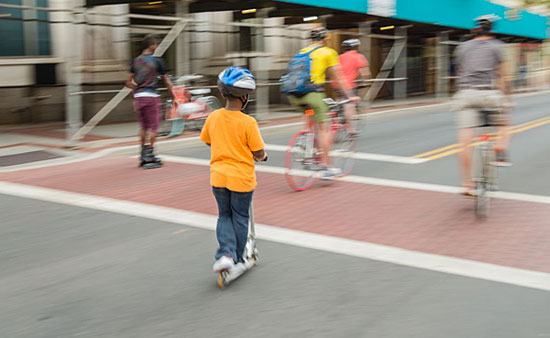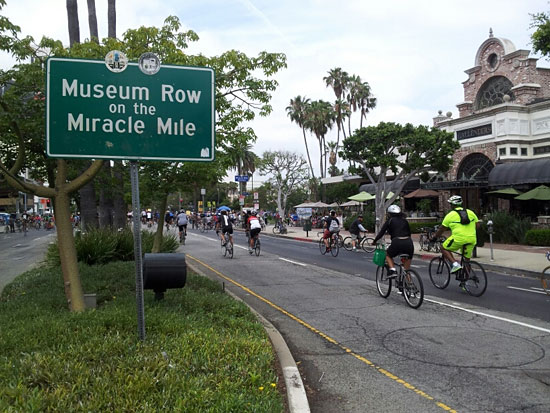Spreading the CicLAvia spirit
April 3, 2014

Folks from New Brunswick, New Jersey, above, to Santa Cruz are catching CicLAvia fever. Photo/Frank Villafañe & Rose Rios
Everybody wants to play in the streets these days.
And CicLAvia, a stereotype-busting open streets free-for-all that became an overnight sensation when it rolled into Los Angeles four years ago, has grabbed the handlebars of what’s becoming a nationwide movement, from small towns to big cities.
As 2014’s first CicLAvia prepares to cruise down a car-free Wilshire Boulevard Sunday, L.A. is hosting the first-ever Open Streets National Summit, drawing activists from around the country who want to see how a metropolis allegedly addicted to automobiles is using CicLAvia to reinvent itself.
Summit organizer Michael Samuelson said L.A. was chosen precisely because of the success of CicLAvia, which regularly draws crowds in excess of 100,000.
“L.A.’s got a fantastic thing going,” said Samuelson. “It’s incredibly popular; the streets are packed with people biking and walking every time.”
The Open Streets Project is working in close collaboration with the CicLAvia organization, which will give summit attendees a behind-the-scenes look at one of the most successful open streets initiatives in the nation, said Aaron Paley, executive director and co-founder of CicLAvia. Paley said that the inherent challenges in shutting down major roads in a city like L.A. are a big part of the success story.
“We are the car capital,” Paley said. “There’s this idea that if you can do it in L.A., then the sky’s the limit.”
CicLAvia started in October, 2010, as a once-per-year event inspired by mid-1970s ciclovias in Bogotá, Colombia. (“Ciclovia” translates roughly to “cycleway.”) By 2013, CicLAvia had grown to three events a year. Paley said that he expects L.A. County to get even more open streets events like CicLAvia as funding grows. “There will probably be 10 or 12 events happening around the county each year,” he said.
As CicLAvia gears up to play an even bigger role in L.A., other communities across the country are hopping aboard. As recently as 2007, only eight or nine open streets events were being held across the country, according to Samuelson. Now, they’re taking place in more than 100 cities across North America.
Some of the initiatives, like Sunday Streets in San Francisco and Summer Streets in New York City, have been serving large, bike-savvy populations for years. But the movement is also gaining traction in cities like New Brunswick, New Jersey (pop. 56,000), which held its first ciclovia last October.
“People were asking ‘Why are we doing this?’ They focused on the negative,” said Jaymie Santiago, organizer of the event and director of program operations for New Brunswick Tomorrow. “It exceeded all our expectations. We expected 2,000 people and got 4,500.”
Building on those results, New Brunswick Mayor James Cahill doubled down, partnering with the organization to produce three more ciclovias this year, starting May 4. Santiago is attending this weekend’s summit so he can bring home valuable lessons and perspective.
“Because of the scale of Los Angeles, it sets an example for smaller cities,” Santiago said. “If L.A. can do it, then New Brunswick can do it.”
At the summit, Santiago plans to share some of the early success of his event, which he said is a useful tool in his organization’s fight against poverty in New Brunswick. “One of the symptoms of poverty is isolation,” he said. “By hosting an event like this and reclaiming the streets, it kind of breaks through that.”
Jenn Graham, an organizer for Atlanta Streets Alive in Georgia, hopes the summit will provide her with ideas on how to partner with her city better. “Our event sticks out like a sore thumb because it’s one of the few that’s not organized by the city or in partnership with a city,” she said. While Atlanta Streets Alive has been able to draw some funding from the city of Atlanta, it has relied primarily on cooperation with businesses and nonprofit organizations. Still, Atlanta Streets Alive has grown rapidly, from about 1,500 people in 2010 to 83,000 last October.
Closer to home, Saskia Lucas of Santa Cruz Open Streets said she is “totally excited” to get her first taste of what she called “the largest open streets event in the United States.”
“I’ve watched videos online and it is just so inspiring to see these thousands of Angelenos just taking over major Los Angeles streets with smiles plastered on their faces.”
More of those smiles may be on tap. Last summer, Metro’s Board of Directors invested $2 million in expanding open streets events to all parts of Los Angeles County. A few months later, the board approved a grant program for local groups seeking to produce events.
The Open Streets summit starts on Friday, April 4. About 75 organizers from across the country will gather at the Line Hotel in Koreatown to share ideas, stories and advice on everything from how to grow partnerships with cities to the technical aspects of producing a safe and successful event.
Things culminate with Sunday’s CicLAvia, which will run from downtown to LACMA, in the Miracle Mile district. Locals and visitors alike will be saying so long—for now—to the six-mile long “Iconic Wilshire Boulevard” route, which is going on hiatus as construction of the Purple Line Extension prepares to get underway.
But never fear: This is Los Angeles, where another CicLAvia always seems to be right around the corner. The next one is coming on October 5 in the “Heart of L.A.” Then, on December 7, the route will focus primarily on South L.A. for the first time ever.
Posted 4/3/4













 405 bridge work causes a stink
405 bridge work causes a stink

